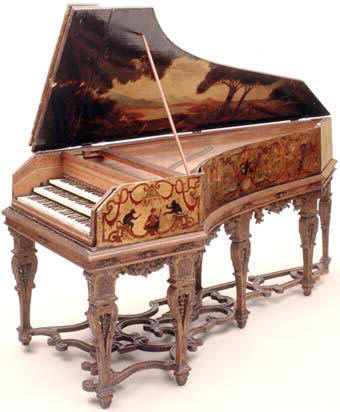![]()
|
Towards establishing the original state of the three-manual harpsichord by Stefano Bolcioni, Florence, 1627, in the Russell Collection of Early Keyboard Instruments, Edinburgh
an article published in The Galpin Society Journal, 53 (2000) 168-200 by Grant O'Brien |
|
Using the methods outlined here it has been possible to determine with a high degree of certainty the original dimensions of the baseboard, the original compass and the original string scalings of the 1627 Bolcioni harpsichord in the Russell Collection. This was made possible only by knowing the size of the local unit of measurement, in this case the Florentine soldo, being used by the builder of this instrument. Assuming that the jacks plucked in the same directions as those in the 1631 Yale harpsichord it was further possible to determine the probable original plucking points for the Russell Collection Bolcioni, although this is clearly dependent upon this assumption. Figure 10 below shows the plan and elevation views of the Edinburgh Bolcioni harpsichord as reconstructed here in its original state. shows a superposition of the reconstructed plan view onto a photograph of the instrument (the treble jackslots have here been covered over and are not visible) and illustrates graphically the extent of the changes which this instrument has undergone.
What I have not shown here, but what seems evident from my analysis of the work of the Florentine makers Francesco Poggio and Bartolomeo Cristofori, is that each of these makers was using a workshop ruler divided up to give a value for the Florentine soldo that was close to the value given by the reference works that I have consulted, but which differed slightly from it. In each case the values are consistent within each workshop, sometimes having values slightly higher or lower than the quoted reference values, but constant and consistent for instruments all coming from the same workshop. This seems to suggest that the methods outlined here, especially for the type of statistical analysis carried out for the register spacing analysis, for example, are capable of giving the size of the unit of measurement of the actual ruler or rulers being used within one workshop. Because there would have been a slight error when dividing up the rulers into their sub-units when doing this by hand, the lengths of the rulers and their sub-divisions would have varied slightly, and this would have resulted in individual variations in the length of the units of measurement which become evident from the type of analysis carried out here. Indeed the slight variations in the quoted values of the units of measurement given by the reference sources also probably have similar origins.
Figure
10 - Re-constructed original plan and
elevation views
Three-manual harpsichord by Stefano Bolcioni, Florence, 1627
Russell Collection of Early Keyboard Instruments, Cat. No. HT1-SB1627.4

